
This appendix shows the tables of characters that are supported by teemX.
Each character set consists of a series of control characters and displayable characters. Displayable characters are alphanumeric, symbolic or graphic characters that can be displayed on the screen or printed by a hardcopy device. Control characters enable the terminal emulation or the printer to perform specific tasks, such as a line feed or carriage return. These will be actioned when received from the host or when teemX is in local mode and they are entered from the keyboard.
Note: When the Display Controls option in the Emulation Settings dialog box is selected, a representation of most control characters received will be displayed on the screen instead of actioned.
To enter a control character from the keyboard, first find the displayable character equivalent by adding 64 to the decimal value of the control character in the relevant character set table. For example, the control character CR (carriage return) has a decimal value of 13. Adding 64 makes 77 which is the decimal value of the displayable character M. When the Ctrl (control) key is held down and Shift + M is pressed, this will generate a CR code in local mode.
Some setup options require you to specify one or more control characters. A control character can be specified by typing ^ to represent the Ctrl key, immediately followed by the displayable character equivalent of the control character as described in the previous paragraph. For example, ^M, represents Ctrl + M, which generates the control character CR.
ASCII CHARACTER SET
(Multinational 7 Bit)

The ASCII (American Standard Code for Information Interchange) character set will be selected when the Keyboard Language option in the Emulation Settings dialog box is set to North American, or the Multinational Mode option in the same dialog box is selected. This table forms the first half of the Multinational character set, the second half of which may be the DEC Additional or one of the ISO Latin Additional sets (as determined by the Preferred Font option in the Emulation Settings dialog box).
NATIONAL REPLACEMENT CHARACTERS

This table shows the characters that replace certain ASCII characters when the Multinational Mode option in the Emulation Settings dialog box is not selected (i.e. set to National character set mode). The national character set consists of the ASCII set with the changed characters listed on the line for the selected keyboard nationality.
DEC ADDITIONAL CHARACTER SET
(Multinational 8 Bit)

This is one of three possible second halves of the Multinational character set (the first half is the ASCII character set and the other possible second halves are the ISO Latin-1 and ISO Latin-2 Additional character sets). These characters may be generated when teemX is in VT400 7 or 8 bit mode and both the Multinational Mode and DEC MCS options are selected in the Emulation Settings dialog box.
ISO LATIN-1 ADDITIONAL CHARACTER SET
(Multinational 8 Bit)
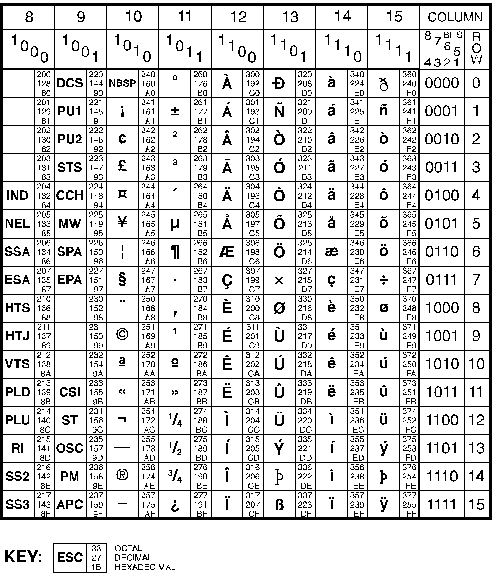
This is one of three possible second halves of the Multinational character set (the first half is the ASCII character set and the other possible second halves are the DEC Additional and ISO Latin-2 character sets). These characters may be generated when teemX is in VT400 7 or 8 bit mode and both the Multinational Mode and ISO Latin-1 options are selected in the Emulation Settings dialog box.
ISO LATIN-2 ADDITIONAL CHARACTER SET
(Multinational 8 Bit)

This is one of three possible second halves of the Multinational character set (the first half is the ASCII character set and the other possible second halves are the DEC Additional and ISO Latin-1 character sets). These characters may be generated when teemX is in VT400 7 or 8 bit mode and both the Multinational Mode and ISO Latin-2 options are selected in the Emulation Settings dialog box.
ANSI 437 CHARACTER SET

This table forms the second half of the ANSI 437 character set, the first half being the ASCII character set.
The ANSI 437 character set is used when the Preferred Font option in the
Emulation Settings dialog box is set to ANSI and the ANSI Codepage option is set
to 437.
ANSI 850 CHARACTER SET

This table forms the second half of the ANSI 850 character set, the first half being the ASCII character set.
The ANSI 850 character set is used when the Preferred Font option in the
Emulation Settings dialog box is set to ANSI and the ANSI Codepage option is
set to 850.
ANSI 852 CHARACTER SET

This table forms the second half of the ANSI 852 character set, the first half being the ASCII character set.
The ANSI 852 character set is used when the Preferred Font option in the
Emulation Settings dialog box is set to ANSI and the ANSI Codepage option is set
to 852.
ANSI 1250 CHARACTER SET
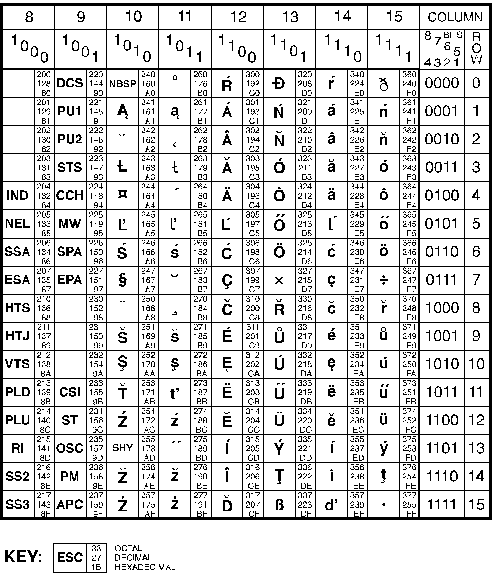
This table forms the second half of the ANSI 1250 character set, the first half being the ASCII character set.
The ANSI 1250 character set is used when the Preferred Font option in the
Emulation Settings dialog box is set to ANSI and the ANSI Codepage option is set to 1250.
DEC LINE DRAWING CHARACTER SET

This is a special DEC character set which is used by some applications.
DEC TECHNICAL CHARACTER SET (7 Bit)

This is a special DEC character set which is used by some applications.
DEC TECHNICAL CHARACTER SET (8 Bit)

This is a special DEC character set which is used by some applications.
IBM 3270 & IBM 5250 ENGLISH (U.S.),
CANADIAN BILINGUAL & NETHERLANDS CHARACTER SET

IBM 3270 & IBM 5250
ENGLISH (U.K.) CHARACTER SET
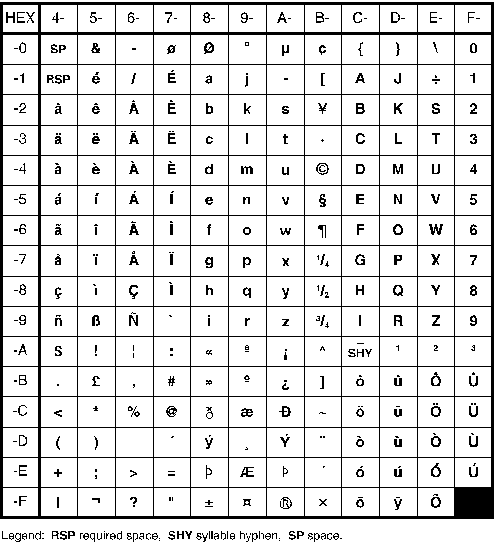
IBM 3270 & IBM 5250
DANISH & NORWEGIAN CHARACTER SET

IBM 3270 & IBM 5250
FRENCH CHARACTER SET
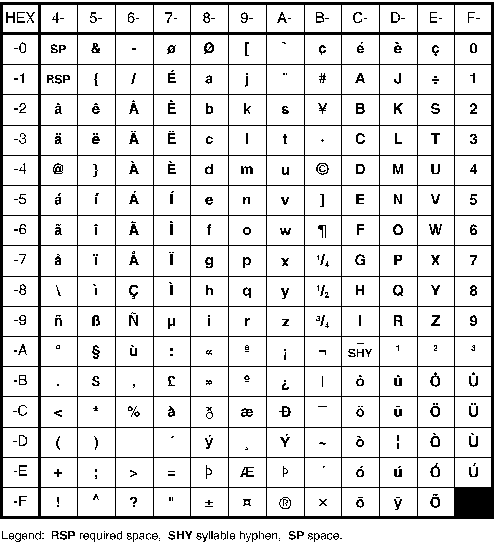
IBM 3270 & IBM 5250
GERMAN & AUSTRIAN CHARACTER SET

IBM 3270 & IBM 5250
ITALIAN CHARACTER SET
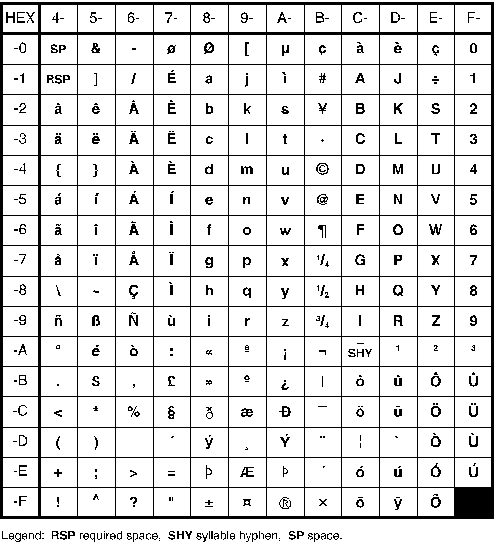
IBM 3270 & IBM 5250
SPANISH CHARACTER SET
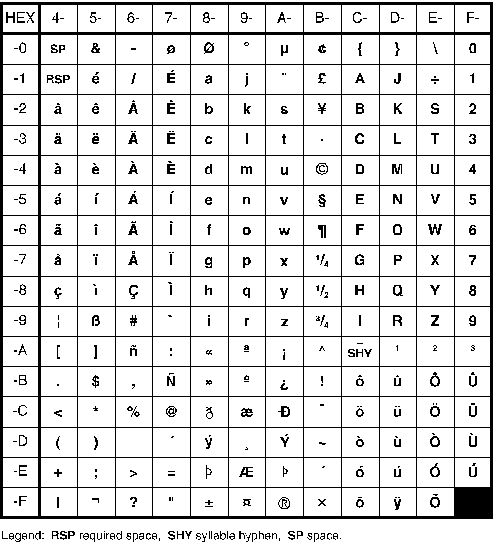
IBM 3270 & IBM 5250
SWEDISH & FINNISH CHARACTER SET
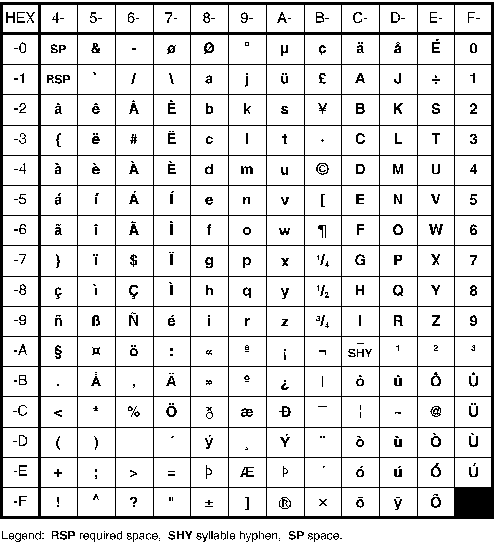
IBM 3270 & IBM 5250 BELGIAN &
SWISS-FRENCH/GERMAN CHARACTER SET
